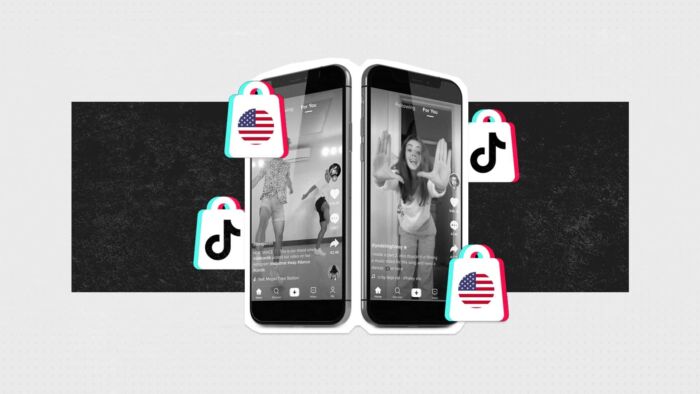The emergence of TikTok Shop, Instagram Shop, Pinterest Shop, and Facebook Marketplace, all indicate one thing – social commerce is rapidly scaling here in the West.
In this blog, we’re delving into the rise of social commerce, exploring its definition and impact on platforms like TikTok, and Instagram, highlighting the rise and potential of this dynamic shopping experience.
What is the current landscape and what future trends will transpire? Stick around as we look to outline the imminent boom of social commerce in the West, and how brands can tap into the rising demand.
Contents
The Rise of Social Commerce in Asia
Social Commerce on TikTok vs Instagram
The Rise of Social Commerce in The West in 2024
How Can Brands Prepare for & Leverage the Growth of Social Commerce?
The Top 3 Benefits of Social Commerce for Marketers & Brand
The Barriers to Social Commerce Adoption
Successful Examples of Social Commerce Marketing Campaigns
The Impending Boom of Social Commerce

What is Social Commerce?
If you’re a regular social surfer, you might have noticed TikTok, Instagram, Facebook, Snapchat, and even Pinterest, have all steadily integrated commerce capacities.
So what exactly is social commerce?
The combination of social media and e-commerce has given shoppers a way to purchase directly through social media networks. With social commerce, the entire shopping experience, from product discovery and research, right through to check out, all takes place in-app.
If you were to scroll down your TikTok FYP right now, you’re likely to see a bunch of creators endorsing a product that is available within the platform’s e-commerce channel, TikTok Shop. So, within minutes you’ve identified a product, heard an influencer’s recommendations, and been promoted to click-through to view the item, which then presents the option to purchase, all without leaving the app.
Social Commerce vs Ecommerce
E-commerce refers to shopping experiences that take place within e-commerce sites, online stores, or branded apps for example. Platforms like Alibaba, Shopify, Amazon, and the likes, are all e-commerce channels, and while you might see their products advertised on social, more often than not, you will be required to navigate away to their websites or platforms to make a purchase.
Social commerce on the other hand allows shoppers to purchase within their social media experience, and it generally tends to be a social-led customer experience.
The Current Landscape of Social Commerce
The Rise of Social Commerce in Asia
While China has been at the forefront of social commerce, the rest of Asia is beginning to scale, especially with major players like TikTok Shop expanding into Southeast Asia. In particular, Indonesia, the platform’s biggest market outside of the US.
In fact, APAC as a region is enjoying the largest successes the social commerce market has to offer. This comes down to the sheer number of internet users who identify with social shopping. a GWI survey of respondents from 9 key markets in APAC identified internet users who are social shoppers by country:
- Indonesia 73%
- Phillipines 72%
- Vietnam 68%
- Malaysia 65%
- India 62%
- Thailand 57%
- China 49%
- Singapore 48%
- Australia 48%
The rise of social commerce throughout APAC has been accelerated by high rates of mobile internet penetration, a mobile-first generation that spends most of its time on social media, and hyper-engagement.
Social Commerce on TikTok vs Instagram
Shopping features are integrated within Instagram, allowing businesses to showcase products in posts, stories, and reels. You’ll typically encounter these products while browsing and can directly purchase them without leaving the app. From a brand perspective, you can create shoppable posts with product tags, enabling seamless exploration and immediate buying options.
Influencers play a pivotal role in the rise of social commerce, endorsing products through sponsored content, and driving sales through their engaged audiences. The platform’s intuitive interface facilitates a smooth transaction process, from product discovery to secure checkout, leveraging Instagram’s social elements to enhance the shopping experience and boost sales for businesses.
TikTok
Having scaled in China on platforms like Douyin (China’s version of TikTok), it’s fitting that TikTok is one of the main catalysts for the rise of social commerce in the West.
Social commerce thrives on TikTok through engaging short-form videos showcasing products. Creators feature tagged items in their clips, leveraging TikTok’s algorithm to reach diverse audiences. Viewers encounter these products seamlessly within the content, often linked to a shopping tab or integrated links for direct purchase.
Hashtag challenges and influencer collaborations amplify product visibility, fostering community interaction and trust. The platform’s “Shop Now” buttons or embedded links streamline the buying process, ensuring a swift transition from discovery to purchase without leaving the app. TikTok’s blend of entertainment and commerce also leverages user-generated content to drive engagement, turning browsing into active shopping experiences.
Live Commerce
‘Live commerce’, ‘live shopping’, ‘live shoppable content’ or ‘TikTok shop’. Whatever you want to call it, this new form of social media shopping experience is booming and you won’t be able to ignore it for much longer. Content distributors, online sellers and big brands alike are rushing to capitalize on rapidly changing consumer behavior, and tracking some jaw dropping results.
While the concept is a relatively recent development for platforms such as TikTok and Instagram, a remote live shopping experience is nothing new, and it has proven effective elsewhere. TV stations such as the world renowned QVC, HSN, TJC and JML have been draining the wallets of their viewers for generations with engaging live video and ‘viral’ products.
The live shopping experience has been catapulted into the 21st century and is fast being adopted by the Gen-Z and Millennial generations, with a plethora of platforms, features and trackability, it’s more powerful than ever.
At Goat we are experts at using live content to drive real time engagement and ultimately product sales. We specialize in working across Facebook and primarily TikTok and YouTube for our clients such as Wayfair and Mattel.
European consumers, surveyed by Statista have expressed huge interest in live commerce whilst brands are reporting record breaking conversion rates. Want to see the stats and learn all about live commerce? Download our exclusive live commerce education deck.

The Rise of Social Commerce in The West in 2024
The idea of social commerce is relatively new on the Western front, but it is far from quiet. Social commerce is beginning to shift shopping habits and platform behaviors at an increasing rate. The stats don’t lie.
Social Commerce Statistics
- In 2022 alone, social commerce generated $53.1 billion in revenue in the U.S., a 34.4% increase over the previous year. (TechTarget)
- Outside of China, the UK holds the largest share (35.9%) of total retail sales generated through retail commerce. (Insider Intelligenece)
- Social commerce is highly influential ahead of the holidays. 70% of US consumers admit they used social media for gift ideas. 60% of Gen Z and 56% of millennial shoppers will use social media for their holiday shopping. (Deloitte)
- 47% of social media marketers say their brand sells directly within social media apps. (HubSpot)
- eMarketer estimates there will be 107M social buyers in the US by the end of 2023. (Statista)
- In the US, nearly 36% of internet users are social buyers, which is approximately 90.2 million people. (Insider Intelligence)
The Catalysts for the Rise of Social Commerce
Social commerce thrives due to interconnected digital landscapes. The nature of social media, and its pervasive presence, creates vast consumer networks that foster product discovery and sharing.
Mobile technology fuels this growth by integrating seamless shopping experiences within social apps, enhancing accessibility and convenience. There are also evolving consumer habits that prioritize peer recommendations and user-generated content, boosting the impact of social commerce.
The personalized nature of advertising algorithms on these platforms further enhances engagement and relevance, catering to individual preferences. Crucially, the integration of transactional features within social platforms simplifies the buying process, encouraging impulse purchases and streamlining transactions.
These catalysts have helped enhance the rise of social commerce, leveraging social connectivity, mobile accessibility, consumer behavior shifts, personalized marketing, and simplified transactions to create a dynamic landscape for buying and selling within the realm of social media.
How Can Brands Prepare for & Leverage the Growth of Social Commerce?
To capitalize on the the rise of social commerce, brands must adapt and strategize. Here’s how:
Seamlessness is key to the social shopping experience
Seamlessness in social commerce ensures a smooth, uninterrupted buying journey within social platforms. It reduces friction, enhancing user satisfaction, and minimizing abandonment rates.
This streamlined experience, optimized for mobile use, encourages quick decisions and impulse purchases. The rise of social commerce owes most of its success to how seamless the process is. For example, it can take mere minutes to identify a product, hear an endorsement, and make a purchase, all without having to leave the app. On TikTok, the experience is near immediate. You could be watching influencer content featuring a tagged product, which when clicked, takes you through to TikTok shop where you can purchase.
If you’re going to leverage social commerce, you need to consider how smooth the process is from discovery to purchasing.
Harness the power of peer recommendations
In today’s social economy, influencer advocacy and recommendations are viewed in the same breath as peer recommendations. In fact, 61% of consumers put their trust in influencer recommendations when considering a product.
With this in mind, you should look to partner with influencers and creators if you want to elevate your social commerce strategy. However, these partnerships are far from one size fits all. Influencer partnerships should make sense, you need to think if a particular creator fits within your brand’s ethos, and whether their content style is right for the product you’re promoting. Getting these partnerships right provides social proof and authenticity, which helps in expanding reach and credibility among potential customers.
The Top 3 Benefits of Social Commerce for Marketers & Brands
1. Shopping on social is an interactive experience
Shopping on social presents consumers with a unique opportunity that isn’t available with other forms of commerce. Consumers can easily consult with their network on purchases, showing off new outfits or other items they’ve purchased through social apps.
The beauty of it comes through the seamlessness.
For example, you’re scrolling through content on TikTok, where you see a creator wearing a top you like. In the comments you’ll typically see people asking where the top is from, as well as sharing their love for it. In addition to these interactions, social commerce and built-in shopping experiences help link users directly to the product they’re after using a ‘Shop Now’ or ‘Buy Now’ call-to-action.
For those who miss the social aspect of a day out at the mall, social commerce might just be the next best thing. Here, you can inspire people with your new outfit, take the compliments, and link them to it if they want to purchase it themselves.
2. Social commerce can alleviate friction
Ever gone to purchase something but the steps from choosing adding to basket to completing order are like navigating a minefield? We call that friction.
See it, click it, buy it, that’s how it should be. Social media shops remove friction from the customer journey, making it easy to follow through from discovery to purchase. Every click of the mouse, or tap on the screen is an opportunity for consumers to change their mind.
So to reduce the risk of abandonment, alleviate the friction by removing unnecessary steps, and bring your shopping experience onto social.
3. Social commerce is a pathway to success
For brands, shopping on social provides new, and innovative, ways to connect with consumers and gain a better understanding of their needs, and how to fill them. Consumers can be reached in the space that they already want to be, which makes them more receptive to product endorsements and malleable toward brand activity.
Social shopping can also provide you with a pathway to try out new content formulas and channels, too. As we mentioned before, live commerce is an effective strategy for real-time shopping on social, but the space remains relatively explored by big retail. Launching a live commerce campaign on TikTok could offer a new, and successful, way for you to reach your target consumer. And, if not, at least you were willing to experiment outside of your traditional formulas.

The Barriers to Social Commerce adoption
According to HubSpot, trust is a big factor for social shopping among social media users, as 54% are concerned that companies selling on social media aren’t legitimate. This stems from the practice itself being fairly new to consumers in Western markets, and the whole idea itself coming across completely alien to older demographics.
Ultimately many people also still view social platforms as a place for entertainment or engaging with their friends and family. The challenge for the platforms will be in shifting that perception and getting users to feel comfortable and even excited to use the shopping functions.
Successful Examples of Social Commerce Marketing Campaigns
Wayfair: Live Commerce on Instagram and TikTok
We helped Wayfair, a leading online home retail brand, elevate its social commerce marketing. We aimed to revolutionize the brand using live commerce by captivating viewers and influencing purchase decisions with engaging, real-time content.
Our approach began with meticulous influencer selection, handpicking 12 standout personalities from a pool of 200. These influencers infused energy into each live stream, transforming Wayfair’s events, from major sales days to casual cooking classes, into vibrant experiences, a pioneering move in the U.S. market. Every product showcased in our live broadcasts were available for users to click-through to and purchase.
Behind the scenes, week-long Instagram and TikTok promotions preceded each live-stream event, garnering unique audiences and creating anticipation. What made these influencers true Wayfair ambassadors? Their deep alignment with the brand’s vision and ethos, coupled with thorough product coaching, ensured authentic and meaningful presentations to viewers.
This resulted in a groundbreaking campaign with 30.2 million engagements and 185K live views, setting a new standard.
Wayfair’s success showcases the power of live-stream marketing within social commerce, driving remarkable brand awareness and customer engagement. Discover the full story in our comprehensive case study.
Zara x TikTok Shop
Zara has become one of the first highstreet fashion labels to list its products on TikTok Shop, enabling direct clothing purchases from within the app.
From what we’ve seen, the retailer showcases curated selections from its womens, kids, and menswear lines on TikTok, using product tagging within its videos for seamless in-app shopping.
Embracing a fresh marketing approach, Zara experiments with user-generated content (UGC)-style product displays, diverging from traditional editorial formats.
TikTok is expanding its shop, introducing new categories like ‘refurbished technology’ for second-hand devices. Launching a logistics program, “Fulfilled by TikTok” (FBT), the platform aims to ease UK sellers’ burdens by handling intricate logistics, enabling merchants to focus on other business aspects. This strategic move highlights Zara’s integration into TikTok’s growing commerce landscape while simplifying the process for sellers.
The Impending Boom of Social Commerce
The rise of social commerce has only just started in Western markets, its imminent surge will be propelled by a convergence of consumer preferences and technological advancements.
Expect to see even more shifts in shopping behaviors that emphasize convenience and trust in peer-driven recommendations. Platforms like Facebook, Instagram, TikTok, and Pinterest are continually expanding their shopping features, making in-app purchases more seamless, catering to a mobile-savvy audience.
What does the future hold for social commerce?
Looking ahead, social shopping will likely evolve in several ways. Augmented Reality (AR) integration could revolutionize the shopping experience, allowing virtual product trials and immersive interactions. Live shopping experiences, such as influencer-led events or real-time product launches, will become more prevalent, fostering direct engagement and sales. AI-driven customer service within social platforms could offer instant support, enhancing user satisfaction.
Expect a deeper integration between online and offline retail, allowing for seamless transitions between digital browsing and physical purchases. Insights from successful Asian models like China’s WeChat and Alibaba, known for seamlessly blending social interactions with shopping, may influence what happens here in the West.
The rise of social commerce promises a more personalized, interactive, and boundary-blurring shopping experience that reshapes consumer habits and redefines the digital retail landscape.
—
Want to learn more about the rise of social commerce, and how it can help elevate your D2C marketing efforts? Get in touch today to find out how we can help you, and check out some of our fantastic case studies!





